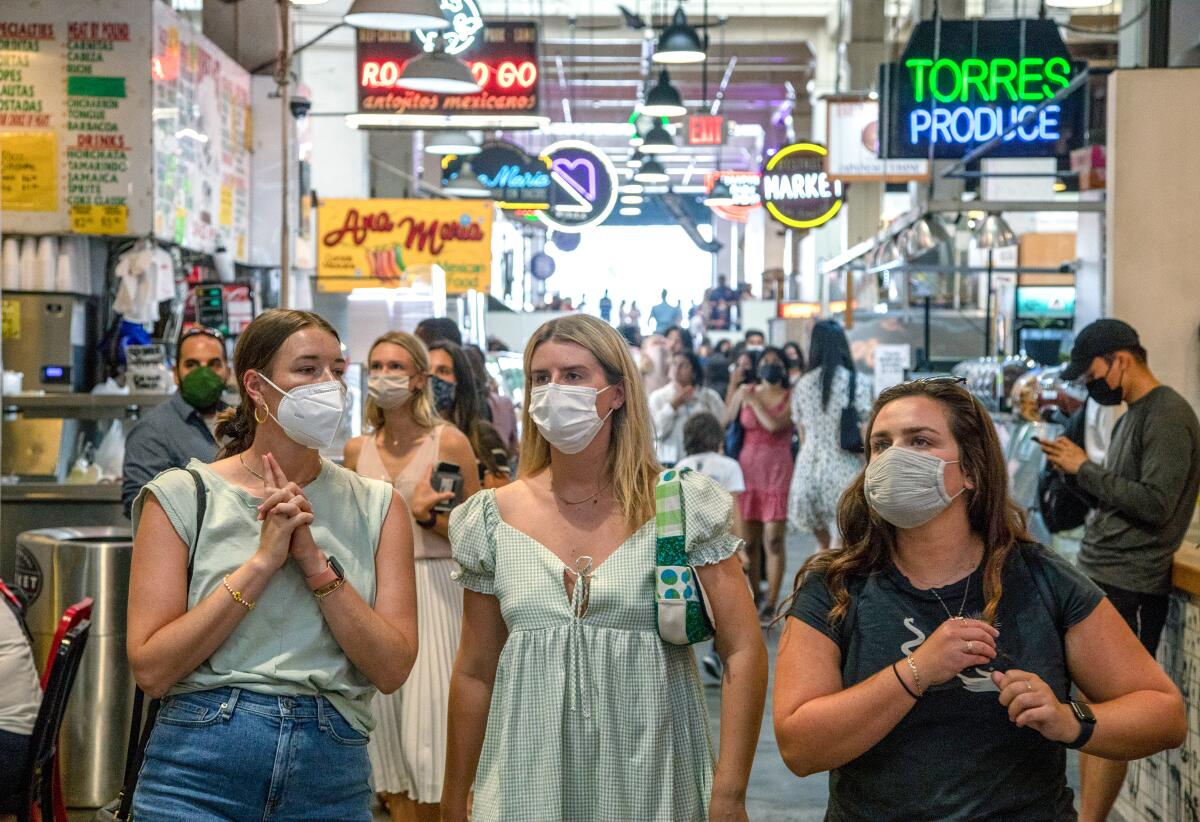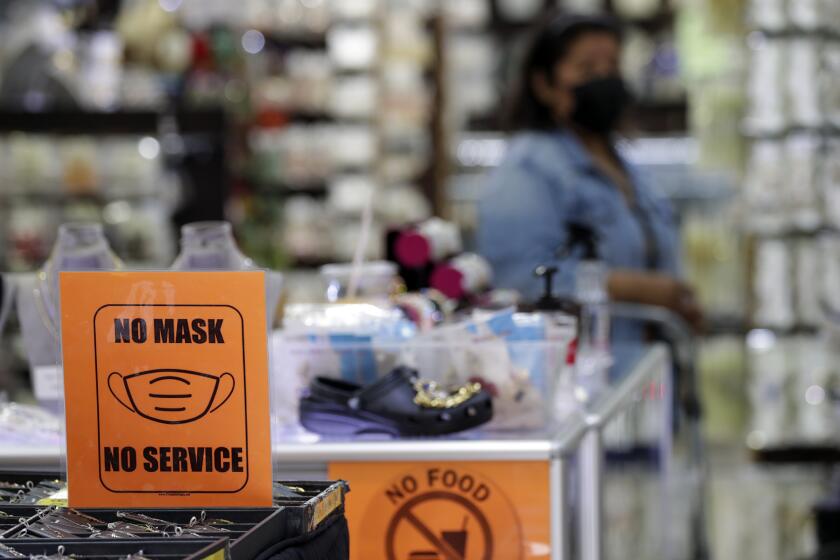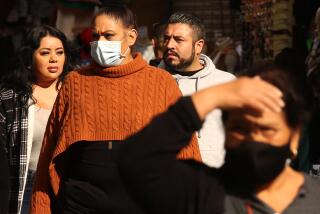L.A. County won’t impose new mask mandate as coronavirus cases decline

Los Angeles County will not reinstitute a universal indoor public mask mandate after marked improvements in the region’s coronavirus case and hospitalization rates.
Aside from scuttling the order, which would have taken effect Friday, the recent downward trends are fueling some optimism that the months-old COVID wave fueled by hyper-infectious Omicron subvariants is finally starting to wane.
“We’re on a decline right now,” L.A. County Public Health Director Barbara Ferrer said Thursday. “We’re glad to see this. It would be welcome relief if this current surge has peaked.”
Based on available data, there is no need for a mandatory masking measure in the immediate future, she said.
“It’s reasonable to assume that the recent decline we have seen in cases will lead to continued decreases in hospital admissions over the next couple of weeks,” Ferrer said. “Although there’s no way to predict the future, the case and hospital admission status suggests that there’s less transmission.”
A renewed face covering order would have applied indoors for anyone 2 or older at a host of establishments and venues, including shared office space, manufacturing and retail settings, event spaces, restaurants and bars, gyms and yoga studios, educational settings and children’s programs.
Masks remain required — as they have for months — in indoor public transit areas in L.A. County, including in taxis, Ubers and Lyfts and in airports, as well as in healthcare settings, nursing homes, jails, prisons, shelters and in settings where businesses or venues require it.
County health officials have for months warned that a new universal indoor mask mandate was a possibility should hospitalizations rise past a certain point.
As the potential implementation date drew closer, the concept became the subject of increasingly intense criticism — from residents, who questioned its necessity and efficacy; from business groups that wondered how it would affect the local economy; and from some elected officials, who expressed concerns about eroding the public’s trust and sparking further pushback.
Despite plans to reinstate a mask mandate in Los Angeles County, the value of widespread masking isn’t what it used to be.
Under L.A. County’s plan, if the region reached the high COVID-19 community level, as defined by the U.S. Centers for Disease Control and Prevention, and remained there for three consecutive Thursdays, a new mask order would be issued.
A high COVID-19 community level means a county is experiencing a significant amount of community spread and has recently recorded at least 10 new weekly coronavirus-positive hospitalizations for every 100,000 residents.
L.A. County entered that category July 14 and remained there last week — positioning Thursday as the pivotal date.
But coronavirus cases started to decline last week, and new hospital admissions dropped too. L.A. County used its own data to calculate new weekly coronavirus-positive hospital admissions as 9.7 for every 100,000 residents — just under the threshold to trigger the mask mandate. The CDC calculated a rate of 10.7, but Ferrer said the federal agency’s data are older than the county’s.
It remains unclear whether L.A. County will continue to pursue a potential mask mandate should there be three future consecutive Thursdays in the high COVID-19 community level.
“We’ve changed frameworks numerous times, in recognition of the changing trajectory of the pandemic,” Ferrer said. “We’ll continue to be mindful of what the data tells us as to what are the most helpful frameworks for us to use as we assess how to keep each other safe.”
As of Thursday afternoon, L.A. County was averaging about 5,900 coronavirus cases a day over the previous week, down 13% from the prior week’s average of 6,800. On a per-capita basis, the latest rate is 409 cases a week for every 100,000 residents. A case rate of 100 or more is considered high.
Some hospitals in L.A. County noticed an increase in hospitalizations this month, but those numbers have dipped.
Centinela Hospital Medical Center in Inglewood was one of them. Dr. Paryus Patel, the facility’s chief medical officer, said he observed a wave of cases in June before dropping back down, followed by another spike over the Fourth of July holiday.
The facility had been seeing three to five people a day hospitalized for COVID-19, a number that rose after the holiday weekend to 12 to 15 people. Those admissions have come down, but people need to stay vigilant, Patel said.
“We’re not 100% immune to getting exposed,” he said.
Patel also said that young Latino patients and older Black residents were among the COVID-19 patients during the most recent wave. He said more Black patients have been infected and are often coming in to the hospital with preexisting conditions exacerbating their illnesses, including heart failure, diabetes and high blood pressure.
The urgent care clinic at Watts HealthCare Corp. has recently observed more sick patients with COVID-19 symptoms, as well as asymptomatic people testing positive for the virus. Dr. Oliver Brooks, the facility’s chief medical officer, said he’s surprised he hasn’t seen a higher level of sickness, such as shortness of breath, pneumonia, dehydration or fatigue.
“I think that’s another reason why we’re seeing a higher case rate — because people are also hearing, ‘Oh, even if you get COVID, you’ll be OK,’ so all of that is kind of feeding together,” Brooks said.
Brooks said the high case rates in recent weeks are likely caused by a combination of the ultra-contagious BA.5 subvariant and pandemic fatigue, with people tired of wearing masks, social distancing and handwashing.
People are generally “putting out more aerosol” these days with hugging, talking and singing with people, he said.
“It’s the summer, and even though people are outside more and it’s less likely to spread [there], people are being more social,” Brooks added. Plus, “they’re also socially together inside more, so they’re on top of each other more… You see, people are not keeping social distance — and I think honestly that’s the main thing.”
While the decision to not go forward with the mask mandate was primarily based on hospital and case rates, Ferrer said her teams analyzed additional data that overwhelmingly supported a recent decrease in transmission.
Health officials say it’s OK to live your life, but it’s smart to ramp up protections, such as masking, testing before events and having good ventilation.
The weekly number of workplaces reporting clusters of coronavirus cases is 399, down from the prior week’s count of 429. Case rates in the poorest areas of the county fell by 5% over the past week. And the California COVID Assessment Tool, published by the state Department of Public Health, estimated that the effective transmission rate in L.A. County was 0.98 as of Thursday — indicating that the spread of COVID-19 is likely stable at this point.
While the viral concentration in wastewater at two of L.A. County’s largest sewage plants remained high, Ferrer said progress was evident, with the facility for the southern and eastern parts of the county recording a decrease in the virus’ presence, and the one for the city of Los Angeles starting to plateau.
She did add that the number of outbreaks at skilled nursing facilities increased slightly.
The step back from masking means that the soon-to-start traditional school year is likely to be mask-optional, as it was in spring. The county announcement elicited a tweet of support from L.A. schools Supt. Alberto Carvalho.
“The right decision at the right time, following the right science,” he tweeted.
Opinion among students, parents and school staffers remains divided, with some families dreading the prospect that mandatory masking would return. Others would have been relieved, given that case rates remain high and the nation’s second-largest school system has discontinued weekly testing for coronavirus infections.
Ferrer continues to strongly recommend indoor masking, including at schools.
Despite the recent improvements, L.A. County is still wrestling with an immense amount of transmission. The latest case average remains far above the peak of last summer’s Delta surge, and officials note the tally is likely a significant undercount due to the widespread use of at-home tests.
The declines could be attributable to a number of factors. As the high spread has become evident in recent weeks, some people are increasingly donning masks and taking other precautions.
It remains unclear whether BA.5 is starting to run out of people to infect, Ferrer said.
With the current prevalence of cases, in a group of 50 people, there’s a 60% to 70% likelihood that someone is infected, she said. “I would strongly advise that everyone keep their masks on.”
“Every infection creates a potential chance of experiencing not only immediate symptoms from COVID, but long COVID,” Ferrer said. “And repeat COVID infections can also increase the risk of other serious health conditions for some. … Given the unknowns, we strongly recommend taking steps to avoid getting infected.”
Although cases are trending downward and hospitalizations are relatively flat, the same can’t be said for deaths, the ultimate lagging indicator of coronavirus spread.
As of Thursday, L.A. County was recording 108 COVID-19 deaths a week, a 16% week-over-week increase. A month ago, L.A. County was reporting 56 deaths a week.
Ferrer called it “disheartening misinformation” when people say that no one dies of COVID. “This ignores the very real suffering and pain of those that are losing family members to COVID, and it ignores the brutal mortality rate that’s still associated with this pandemic,” Ferrer said.
Nearly 4,400 people died of COVID-19 countywide over the first half of this year. That toll is twice as high as the typical six-month average number of deaths from drug overdoses, the flu and car crashes combined, according to county health figures.
Times staff writer Howard Blume contributed to this report.
More to Read
Sign up for Essential California
The most important California stories and recommendations in your inbox every morning.
You may occasionally receive promotional content from the Los Angeles Times.
















